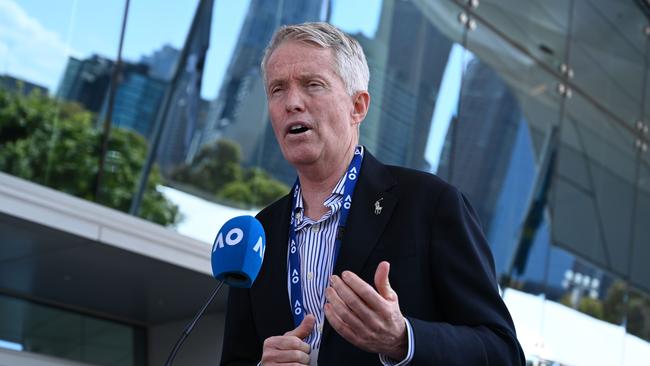Tennis Australia in $100m loss and $40m loan after Covid hit
The sport’s governing body is optimistic it can recover after a tough 2021 that saw its lucrative Australian Open hit by low crowds during Covid.

The delayed and Covid-hit 2021 Australian Open and huge biosecurity spending cost Tennis Australia $100m and forced the governing body to take out a $40m loan, financial accounts reveal.
Tennis Australia also spent its $80m reserves in a year that saw the Australian Open delayed from its usual mid-January timeslot, had its television broadcast revenue cut and saw several days of play before no crowds due to a Covid outbreak in Melbourne.
The full extent of the Covid hit and the cost of moving players to Australia from all around the world and housing them for the required two weeks quarantine was laid bare in Tennis Australia’s 2021 accounts, obtained by The Australian.
Tennis Australia posted a $99.9m net loss for the 15 months to September 30 from revenue of about $360m. The organisation’s income for the period was almost $100m less than the record $455m revenue it made in what had been a bumper 2020 financial year – which featured the last Australian Open held before the global pandemic.
The 2021 accounts reveal that Tennis Australia took out a $41.02m loan from the Victorian state government in February to help the organisation hold the Australian Open during Covid. It also received $19m in government grants.
But Tennis Australia chief executive Craig Tiley sounded an optimistic note as ticket sales surge for the upcoming 2022 Australian Open in January and said it would be easy to be “disappointed” with the 2021 financial result after years of growth.
“We delivered the first major international sporting event with crowds at the height of the pandemic providing much needed playing opportunities (and) allowed us to maintain a connection with the playing group. While the quarantine conditions were difficult for many of them, the overwhelming response from players is that they are excited and looking forward to coming back for 2022.
“While ticketing revenue, naturally took the biggest hit, with closed international borders, unstable domestic borders, zoning on site, a significantly delayed on-sale date – and a five-day snap lockdown in the middle of the event, by maintaining the connection through 2021, we are experiencing a return to (sponsor) revenues for the upcoming summer and broadcast revenues are experiencing significant growth, with new contracts achieving results better than pre-pandemic levels.”
Tennis Australia is paying 4.163 per cent interest per year on the state government loan, which is due for full repayment in February 2039. The state government had agreed to the funding after Tennis Australia extended its Australian Open contract to host the event in Melbourne by three years, guaranteeing that the Open will remain a summer fixture in the Victorian capital for at least another 19 years.
Meanwhile, Tennis Australia also was forced to spend its entire $80m reserves it had built up over several years as a financial buffer should a worst-case scenario such as a tournament cancellation ever happen.
While that did not eventuate, the additional costs and big revenue hole meant that the reserves were fully exhausted to cover operational expenses.
“Plans for replenishment of reserves have been considered,” a note in the accounts said. ”It remains the objective of the organisation to return as promptly as possible to generating a profit from the (Australian Open) and increase diversified revenue streams to enable a surplus to replenish the reserve balance.”
Tennis Australia was previously in rude financial health compared to most other sports in the country, and last year had net assets of more than $100m – including the $80m reserves.
But the organisation’s latest balance sheet shows it now has only $2.4m net assets.
It also is contributing $1.9m to develop a regional tennis centre in Launceston and will spend $1.2m on marketing for the upcoming Australian Open and another $3.6m for technology projects.
In July, Tennis Australia formed a venture capital fund targeting technology and health start-ups, and clinched a multi-million-dollar deal for its first investment.
The governing body formed Wildcard Ventures, which has made a multi-million-dollar investment in US artificial intelligence sports tech business SwingVision.
In a rare move for an Australian sport, Wildcard Ventures is also acting as a syndicate and potentially bringing in other investors to its deals.



